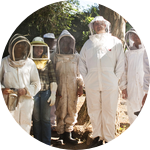About This Project
Question: How can we reduce the level of pesticide contamination in the supply of commercial bees wax that is now the basis for most of American beekeeping? Goals: 1) Develop a simple method for reducing pesticide levels in small batches of recycled beeswax. 2) Publish any positive results so that beekeepers can begin to use the technique. 3) Maintain the working research/education apiary at UW so that this and other minor projects can continue to be used to train student scientist beekeepers.Ask the Scientists
Join The DiscussionWhat is the context of this research?
We are training a new generation of science-saavy beekeepers that have a full appreciation for the value of bees and pollination and the tools to succeed in apiculture while helping to solve modern problems in the field.
What is the significance of this project?
Recent research showing contamination of the beeswax supply with miticides made it imperative in my mind to find solutions that will enable beekeepers to access or make clean wax foundation for use in standard hives. Problems with Varroa have been a focus of interest for me for 25 years and Nosema ceranae has become widespread and appeared in my bee operations in the past 2 years, causing significant loss.
What are the goals of the project?
1) Develop small-scale wax purification technique for providing healthy brood foundation (lowering chemical stress levels on larval bees)
2) Test integrated management methods and locally-produced stock for tolerance of Varroa mites and Nosema ceranae.
Budget
High-resolution analysis of wax samples by a professional lab. Minimum of 8 samples @ $207.50 = $1660.00.
Maintenance of 6-8 research hives, including materials for monitoring and experimental treatment of Varroa & Nosema @ $100.00 = $800.00.
Meet the Team
Affiliates
PhD Entomology, University of California, Davis 1984
Instructor at Biology Dept., University of Washington, Seattle
Instructor at Interdisciplinary Arts & Sciences, Univ. WA, Tacoma
Owner of Entomo-Logic , Monroe, WA
Team Bio
My experiences are diverse. I have traveled widely. I have many skills. Below is a brief summary of my professional life in resume format:
- 1976. B.A. Biology, University of Utah.- 1984. Ph.D., Entomology, University of California, Davis. Thesis: Ecology of perturbations in natural plant-pollinator systems.
- 1984-85. Apicultural development scientist, Honey Production International, Dubai, United Arab Emirates. Focus: development of honey-producing apiaries; investigation of indigenous apiculture and native bee ecology.
- 1985-87. NSF-funded postdoctoral scholar, Australian Museum, Sydney, Australia. Focus: ecology of native bee-honey bee interactions.
- 1987-88. Technical Assistant, Exotic Pest Program, California Department of Food and Agriculture. Focus: development of exotic pest profiles; assisted in administration and field work for Medfly and Oriental Fruit Fly eradication programs.
- 1988-92. U.S. Department of Agriculture, Agricultural Research Service, Weslaco, Texas. Focus: research on ecology and impact of Africanized (\"Killer\"") Bees.
- 1993-94. Kentucky State University. Visiting researcher. Focus: honey bee parasites and their control.
- 1995 - 1997. Consultant in editing, illustration, exhibit design.
- 1997 - present. Entrepreneur, small business owner. Focus: management and production of solitary pollinator bees and honey bees.
- 1998-present. Instructor, Biology Dept., University of Washington, Seattle and Tacoma. Focus: Entomology, Ecology, Bees & Beekeeping.
Other teaching appointments: Edmunds Community College, 2006; University of Oregon, 2010.
Evan A. Sugden
My experiences are diverse. I have traveled widely. I have many skills. Below is a brief summary of my professional life in resume format:
- 1976. B.A. Biology, University of Utah.- 1984. Ph.D., Entomology, University of California, Davis. Thesis: Ecology of perturbations in natural plant-pollinator systems.
- 1984-85. Apicultural development scientist, Honey Production International, Dubai, United Arab Emirates. Focus: development of honey-producing apiaries; investigation of indigenous apiculture and native bee ecology.
- 1985-87. NSF-funded postdoctoral scholar, Australian Museum, Sydney, Australia. Focus: ecology of native bee-honey bee interactions.
- 1987-88. Technical Assistant, Exotic Pest Program, California Department of Food and Agriculture. Focus: development of exotic pest profiles; assisted in administration and field work for Medfly and Oriental Fruit Fly eradication programs.
- 1988-92. U.S. Department of Agriculture, Agricultural Research Service, Weslaco, Texas. Focus: research on ecology and impact of Africanized (\"Killer\"") Bees.
- 1993-94. Kentucky State University. Visiting researcher. Focus: honey bee parasites and their control.
- 1995 - 1997. Consultant in editing, illustration, exhibit design.
- 1997 - present. Entrepreneur, small business owner. Focus: management and production of solitary pollinator bees and honey bees.
- 1998-present. Instructor, Biology Dept., University of Washington, Seattle and Tacoma. Focus: Entomology, Ecology, Bees & Beekeeping.
Other teaching appointments: Edmunds Community College, 2006; University of Oregon, 2010.
Additional Information
Beeswax, used by beekeepers to supply bees with materials for making new comb, in which larval bees are reared, is pooled over many beekeepers and from many localities as it is a recycled material. Synthetic miticides, once commonly used to control exotic mites, are chemically attracted to the wax. The wax supply is now contaminated with these substances, which are toxic in very minute amounts to larval bees. Many scientists suspect this is a stress factor on the bees that may be contributing to "collony collapse disorder, a.k.a. "disappearing disease". There are no economical ways to clean the wax on a commercial scale, but it may be possible for individual beekeepers, or local associations, to purify small batches of wax to make their own, relatively "pure" wax. Developing more effective ways of deploying organic Varroa mite and Nosema (a parasitic mite and a fungus) controls is now an on-going project all over the world. We can make a contribution by testing existing methods locally. Of more long-term importance is testing resistant honey bee queens for the performance of their offspring relative to these problems. This is also wide-based research, often done by beekeepers, to which we are contributing data.Project Backers
- 15Backers
- 42%Funded
- $1,170Total Donations
- $73.13Average Donation
